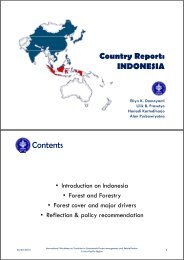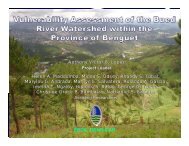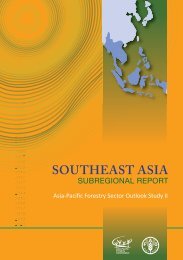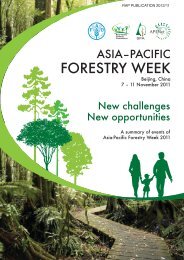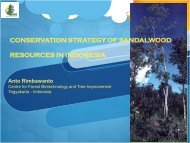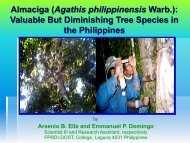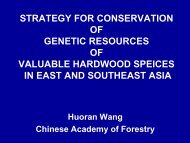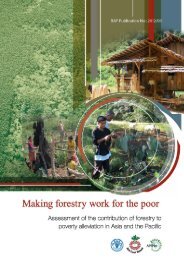Community guidelines for accessing forestry voluntary carbon ... - FAO
Community guidelines for accessing forestry voluntary carbon ... - FAO
Community guidelines for accessing forestry voluntary carbon ... - FAO
You also want an ePaper? Increase the reach of your titles
YUMPU automatically turns print PDFs into web optimized ePapers that Google loves.
<strong>Community</strong> <strong>guidelines</strong> <strong>for</strong> <strong>accessing</strong> <strong>for</strong>estry <strong>voluntary</strong> <strong>carbon</strong> markets<br />
Box 7: Carbon rights<br />
Carbon rights have become a key cause of concern <strong>for</strong> many of the<br />
civil society organizations that follow the development of <strong>for</strong>est<br />
<strong>carbon</strong> projects.<br />
Very few countries have attempted to define what is meant by a ‘right<br />
to <strong>carbon</strong>’, nor what benefits such rights give to the right-holder. In<br />
Australia and New Zealand, it is understood as a new <strong>for</strong>m of property<br />
right. The <strong>carbon</strong> in <strong>for</strong>ests is there<strong>for</strong>e seen as a commodity that can<br />
be traded separately from the <strong>for</strong>est itself.<br />
This only really makes sense where a <strong>for</strong>est is clearly and legally owned<br />
by a single party, who can divide up the property in whatever manner<br />
they like. But in most of the Asia-Pacific region, where <strong>for</strong>est use rights,<br />
if not <strong>for</strong>est tenure, are traditionally held in common, treating <strong>carbon</strong><br />
as a separate property is at best confusing and at worst a source of<br />
misunderstanding and conflict.<br />
If <strong>carbon</strong> rights cannot be considered separately from the <strong>for</strong>est as a<br />
whole, project developers <strong>for</strong> the VCM should instead turn directly<br />
to <strong>for</strong>est use rights and ownership. ‘Carbon rights’ derive directly<br />
from existing traditional and legal <strong>for</strong>est use rights. VCM projects<br />
must resolve any outstanding disputes over these use rights be<strong>for</strong>e<br />
proceeding with the project.<br />
The holder of a ‘<strong>carbon</strong> right’ has the right to benefit financially from<br />
the trade in environmental services, where the service is climate<br />
change mitigation, and the unit of trade is a <strong>carbon</strong> credit.<br />
For more in<strong>for</strong>mation, see REDD-net Asia-Pacific Bulletin 3: Carbon Rights and<br />
REDD+ available from http://redd-net.org/resource-library/<br />
58




